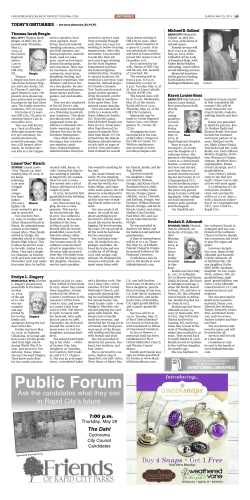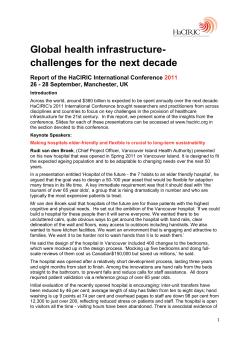
Document 95977
Notes 452 p. 109-l 3 1. In Z. Dubinsky [ed.], Coral reef ecosystems. Elsevier. -, AND J. M. LOUGH. 1989. The nature of skeletal density banding in scleractinian corals: Fine banding and seasonal patterns. J. Exp. Mar. Biol. Ecol. 126: 119-134. BEN-ZION, M., Y. ACHITUV, N. STAMBLER, AND Z. DUBINSKY. 199 1. A photographic, computerized method for measurements of surface area in Millepora. Symbiosis 10: 115-l 2 1. BOSCHMA, H. 1948. The species problem in Millepora. Zool. Verh. Leiden 1: l-l 15. HUSTON,M. 1985. Variation in coral growth rates with depth at Discovery Bay, Jamaica. Coral Reefs 4: 1925. LEWIS,J. B. 1989. The ecology of Millepora. Coral Reefs 8: 99-107. LOGAN,A., AND I. H. ANDERSON. 199 1. Skeletal extension growth rate assessment in corals, using CT scan imagery. Bull. Mar. Sci. 49: 847-850. AND T. TOMASCIK. 199 1. Extension growth rates in ‘two coral species from high-latitude reefs in Bermuda. Coral Reefs 10: 155-160. LoYA, Y. 1972. Community structure and species diversity of hermatypic corals at Eilat, Red Sea. Mar. Biol. 13: 100-123. 1976. Settlement, mortality and recruitment of a Red Sea scleractinian coral population, p. 89-100. Zn G. 0. Makhie [ed.], Coelenterate ecology and behavior. Plenum. MERGNER,H. 197 1. Structure, ecology, and zonation of Red Sea reefs (in comparison with South Indian and Jamaican reefs). Symp. Zool. Sot. Lond. 28: 14 l-l 6 1. Limnol. Oceanogr., 39(2), 1994,452-458 0 1994, by the American Society of Limnology and Oceanography, MOYSE,J. 197 1. Settlement and growth pattern of the parasitic barnacle Pyrgoma anglicum, p. 125-l 4 1. Zn 4th Eur. Mar. Biol. Symp. Cambridge. RAHAV, O., M. BEN-ZION,Y. ACHITUV,AND Z. DUBINSKY. 1991. A photographic, computerized method for in situ growth measurements in reef-building cnidarians. Coral Reefs 9: 204. RHOADS,D. C., AND R. A. LUTZ. 1980. Skeletal records of environmental change, p. 1-16. Zn D. C. Rhoads and R. A. Lutz [eds.], Skeletal growth of aquatic organisms. Plenum. Ross, A., AND W. A. NEWMAN. 1973. Revision of the coral-inhabiting barnacles (Cirripedia: Balanidae). San Diego Sot. Nat. Hist. Trans. 17: 137-l 74. STEARN,C. W., AND R. RIDING. 1973. Forms of the hydrozoan Millepora on a Recent coral reef. Lethaia 6: 187-200. STEPHENSON, T. A., AND A. STEPHENSON.1933. Growth and sexual reproduction in corals. Sci. Rep. Great Barrier Reef Exped. 1928-29 3: 167-217. WEERDT,W. H. DE. 198 1. Transplantation experiments with Caribbean Millepora species (Hydrozoa, Coelenterata) including some ecological observations on growth forms. Bijdr. Dierkd. 51: 1-19. 1984. Taxonomic characters in Caribbean Millejora species (Hydrozoa, Coelenterata). Bijdr. Dierkd. 54: 243-362. YONGE, C. M. 1963. The biology of coral reefs. Adv. Mar. Biol. 1: 209-260. Submitted: 11 November 1992 Accepted: 7 July 1993 Amended: 25 August 1993 Inc. Regional pattern of riverine dissolved organic carbon in the Amazon drainage basin of Bolivia Abstract-Dissolved organic carbon (DOC) was analyzed at 11 hydrometric stations and 4 1 Andean and lowland sites in the upper Rio Madeira drainage basin where anthropogenic alteration is low. The two regions, Andes and Llanos, behave very differently. Mean DOC is 2.2 mg liter-’ (range, 1.24.2 mg liter-I) in the Andes and 5.7 mg liter-’ (range, 4.87.4 mg liter-l) in the Llanos. DOC enrichment may occur rapidly as Andean rivers enter the Llanos. The specific DOC export is correlated with the watershed forested area in the Andes but not in the Llanos. Specific DOC yield for a given water runoff is 3 times Acknowledgments We acknowledge the staff of the SENAMHI and IIQUMSA for field assistance in Bolivia. We are indebted to H. Sanejouand and P. Namour of the CEMAGREF (Lyon, France) for organic carbon analysis and to M. Meybeck for comments. higher in the Llanos. Regionalization seems important for predicting DOC dynamics in such a large basin. The biogeochemistry of organic C in the Amazon River has been extensively investigated with regard to origin, processes, and budgets (e.g. Richey et al. 1990). Richey et al. sampled Amazon tributaries near their confluence to determine their contribution to mainstem functioning. However, little is known about the origin of organic C in the upper drainage basins of the Amazon. The relative contribution of the different regions and landscapes to riverine carbon yields remains poorly documented. Although increasing colonization is leading to rapid landscape alterations in some Notes 453 Fig. 1. Map of the Amazon drainage basin of Bolivia: sampling points-o; PHICAB gauging stations-*; major cities-m. Letters refer to the five regions: A-upper Rio Beni; B-Rio Grande; C-Chapare, for the Andes; D-Rio Beni; E-Rio Mamore, for the Llanos. Stations codes given in Table 1. regions, the global impact of such development on the organic C fluxes in these rivers is hardly predictable. The drainage basin of the Rio Madeira upstream of the Brazilian frontier extends over 900,000 km2 and supplies on average 18,000 m3 of water s-l. Andean tributaries are known to provide most of the yields for both dissolved and sediment loads (Roche and Fernandez 1988; Guyot et al. 1988), but nothing is known about organic C. This large, highly contrasted, and still relatively pristine tropical basin now constitutes a study area of high interest, inasmuch as it is covered by the PHICAB hydrological network which has been providing daily data on discharge and total dissolved and suspended solids (TDS and TSS) at 11 gauging stations since 1983. Our study was designed to investigate the spatial pattern of riverine dissolved organic C (DOC), to identify possible causes of variation, and to propose a framework for the regionalization of the DOC dynamics. The Bolivian portion of the upper Rio Ma- 454 Discharge -1 Notes (m3 s-l) ” u 1 2 u ” 3 4 DOC (mg liter-l) ” Discharge 1987 1988 Fig. 2. Mean daily discharge of Rio Beni at Angosto de1 Bala (A24) and Cachuela Esperanza (D5), 1987-l 988. Numbers on upper axis (l-4) indicate sampling periods at the PHICAB stations. deira drainage basin (74% of the total basin area) is clearly divided into two geographic zones: the eastern slope of the Andes, ranging from 6,500 to 250 m, and the plain (“Llanos”), extending from the Piedmont of the Andes to the Brazilian shield (Fig. 1). Individual watersheds in the Andes are heavily contrasted; they range from semiarid basins on the Altiplano quaternary sediments to densely vegetated hyper-humid basins on Paleozoic rocks. That large zone has been subdivided into three regions. The upper Rio Beni drainage basin (A on Fig. 1) is made up of deeply incised, humid (rainfall, 1,500-3,000 mm yr- l), forested valleys: the “Yungas” and the Alto-Beni foothills; it also includes some semiarid (rainfall, ~800 mm yr- l), highly erodible basins (Rios La PazBoopi and Consata). The Rio Grande drainage basin (B), which culminates at 5,100 m, is entirely semiarid. The Chapare region (C) is made up of densely forested mountains and reaches 4,500 m; in this region, as in other peripheral parts of the Amazon basin, precipitation is maximal (5,000-7,000 mm yr- ‘) at very low elevations in the contact zone between the Andes and the Llanos and decreases to 2,000 mm yr-’ with increasing altitude. The extreme variability of mechanical erosion rates in adjacent basins must be emphasized (l,OOO20,000 t km-2 yr- l, Guyot et al. 1988). Highly turbid rivers flowing out from the Andes (Madre de Dios, Beni, and Mamore) correspond to white-water rivers. The Llanos is a nearly flat plain of recent alluvial sediments whose level is controlled by the Precambrian Brazilian Shield outcrop 15-Mar-BB (m3 s-l) Fig. 3. DOC vs. discharge on the Rio Beni at Angosto de1 Bala (A24). near Cachuela Esperanza (D5) and Guayaramerin (El 1). About 150,000 km2 are flooded annually in this region, inducing the development of Savannah patches. Annual rainfall is -2,000 mm in the Rio Beni catchment (D), which is covered mainly by tropical evergreen to seasonal forest. In region E, rainfall ranges from 2,000 mm yr- l in the north to 1,100 mm Yr -l in the southeast where a tropical seasonal forest progressively gives place to tropical savannah. Human densities are low, -7 inhabitants km-2, including major cities, and - 1 inhabitant km-2 in the Llanos. Accessibility to most rivers is difficult. Pollution is restricted to some large cities. Hydroelectric reservoirs are small and located at high altitude; channelization is unknown. Agriculture is traditional with many sites of active rural colonization in the Chapare, Alto-Beni, and Llanos. The 11 PHICAB gauging stations located in the Andean Piedmont and the Llanos were sampled 2-4 times, corresponding to different -1 Utitude (m) P 2 % OA P AP P “? 4A A 4 8 DOC (mg liter-l) Fig. 4. Mean DOC value vs. sampling point altitude. Points referenced by region (Table 1, Fig. 1); P indicates a polluted river. Notes 455 Table 1. Data for rivers of the Amazonian drainage basin of Bolivia. River sample points, characteristics, and mean results. Alt. -sample point altitude (m); A -drainage basin area (km*); qs- specific discharge or runoff (liter s- * km-*); F-forested area (%) in the watershed ([ ~1= % of forested area for Bolivian area only); n -number of organic C samples; DOC-average values (mg liter-‘); qs x DOC-DOC-specific yields (g m-2 yr-I). Code River Alt. A qs Al A2 A3 A4 A5 A6 A7 A8 A9 A10 All A12 Al3 Al4 Al5 Al6 Al7 A18 Al9 A20 A21 A22 A23 A24t Bl B2 B3 B4-t Cl c2 c3 c4 C5 C6 c7 C8 Dlt D2t D3 W D5t El E2-t E3 E4 E5 E6t E7 E8 E9-t ElOt El lt San Cristobal Consata Mapiri Tipuani Challana Zongo San Juan Coroico Coroico Kaka Unduavi Taquesi Tamampaya La Paz* La Paz* Luribay La Paz* Miguillas La Paz Boopi Boopi Cotacajes Alto Beni Beni Rocha* Tapacari Arque Grande Esperitu Santos San Mateo Chimore Sajta Ichoa Ichilo Yapacani Piray* Beni Madre de Dios Beni Orthon Beni Grande Ichilo Ichilo-Mamore Secure Mamore Mamore Tijamuchi Apere Mamore Itenez-Guapore Mamore 2,400 900 500 500 500 1,200 1,200 800 500 480 1,200 1,200 500 2,400 2,000 2,550 800 800 500 450 400 400 380 280 2,450 2,500 2,400 450 300 300 210 220 230 240 280 280 130 130 125 120 110 250 190 175 165 150 145 140 135 120 115 110 110 2,400 10,100 1,400 1,900 330 100 610 5,400 18,800 280 620 2,100 930 1,100 810 5,200 1,000 7,400 10,900 12,500 16,000 29,100 67,500 3,600 940 2,300 59,800 2,700 2,400 1,900 2,100 670 2,100 6,900 4,100 119,000 124,200 243,000 32,300 282,500 67,000 7,600 124,000 17,000 144,000 159,100 7,600 17,000 216,200 354,300 599,400 16 16 18 26 55 50 50 43 33 26 19 19 19 11 11 11 11 11 11 13 15 20 21 30 5 5 5 5 70 70 70 70 70 70 13 13 24 41 34 14 32 8 78 30 30 22 20 30 30 25 6 14 * Polluted 7 PHICAB river. gauging station. DOC 0 0 47 34 66 15 4 34 77 57 0 0 15 0 0 0 0 0 2 11 22 46 37 58 1 0 0 18 76 77 100 97 100 100 77 63 [& [681 [lOOI 1721 27 99 49 77 53 52 15 60 [E] [621 1 1 2 2 1 1 1 1 2 2 1 1 1 1 1 1 1 1 1 1 1 1 2 17 1 1 1 3 1 1 1 1 1 1 1 1 3 3 1 3 3 1 2 2 1 1 3 1 1 4 2 3 1.5 1.7 1.8 1.7 1.8 1.7 1.6 1.8 1.7 1.8 1.2 1.4 1.6 6.8 5.0 1.5 4.0 1.9 2.1 2.3 2.5 2.2 2.3 2.8 6.5 2.0 2.2 3.1 1.7 1.6 1.3 2.1 2.4 4.2 3.4 4.5 4.8 4.9 4.8 7.0 5.7 6.3 7.4 5.3 5.8 6.0 6.1 5.5 6.2 5.5 5.9 4.8 qs x DOC 0.8 0.9 1.0 1.4 3.1 2.7 2.5 2.4 1.8 1.5 0.7 0.8 1.0 2.4 1.7 0.5 1.4 0.7 0.7 0.9 1.2 1.4 1.5 2.6 1.0 0.3 0.3 0.5 3.8 3.5 2.9 4.6 5.3 9.3 1.4 1.8 3.6 6.3 5.1 3.2 5.7 1.6 18.2 5.0 5.5 4.2 3.8 5.2 5.9 4.3 1.1 2.1 456 Notes Table 2. Minimum, average, and maximum values of mean DOC contents (mg liter- ‘) in unpolluted stations of the five regions. (Regions identified in Fig. 1.) No. -number of stations by region. Domain Andes Llanos Region No. Min A B C D E 21 3 7 5 11 1.2 2.0 1.3 4.8 4.8 DOC (mg liter-l) FEI ;/:: Max 1.9 2.4 2.4 5.4 5.9 2.8 3.1 4.2 7.0 7.4 hydrological phases (Fig. 2): low flow (JulyAugust 1987), rising levels (November 1987, December 1988), and high flows (March 1988). Major rivers in the Andes were sampled once in March, April, or June 1988, and a 15-d flood episode was studied at one station. In the turbulent Andean rivers, samples were taken at the river’s edge. In the Llanos, surface samples were taken in the middle of the river. Measurements made with depth-integrating samplers (USD 49) at gauging stations exhibited very good homogeneity of TDS over the whole cross-section, the C.V. being i 0.05 for 95% of the trials. Samples were passed, on location, through a glass-fiber filter (GFK) previously heated at 550°C. The samples were then acidified (H3P04, pH 2), stored in the dark, and sent to the CEMAGREF laboratory in Lyon (France). DOC determinations were performed with a nondispersive infrared analyzer (Dhormann DC80). Ninety-three samples from 52 sites were processed. Percentage of forested area was calculated for each station watershed with a vegetation map of Bolivia (Brockmann 1978) assuming that no significant large-scale alteration of the vegetative cover has occurred in the past 15 yr. Five stations contaminated by the cities of La Paz (Al 4, A 15, A 17) Cochabamba (Bl), and Santa Cruz (C8) were not used. DOC was measured daily during an annual flood episode at the Angosto de1 Bala gauging station (A24) which controls the Rio Beni output from the Andes. DOC contents varied between 2.7 and 5.1 mg liter-l, but with no direct relation with either discharge (Fig. 3) or TDS during such events. The flushing effect (i.e. increased DOC with increased discharge) observed by various investigators therefore seems limited. Still, the lowest value for this station (1.3 mg liter-l, 28 August 1987) corresponds Rio Grande ,i Rio Mamore -4 pq .2 04 ; B2-B3 *A- .--yxC i C3-C6 2600 2ooo Distance 1600 1000 from Beni river confluence 500 PO 0 (km) Fig. 5. Downstream evolution of mean DOC content along the Rio Mamore and its Andean tributaries. Stations identified in Table 1. to the lowest flow situation observed in the 1983-1989 period. Thus, as previously observed in tropical South America (Lewis et al. 1986; Richey et al. 1990) and in the Gambia River (Lesack et al. 1984) DOC values for a particular river seem to have limited variations (1-3-fold) on a broad temporal scale. Consequently, we used average values to characterize spatial variations. Detailed results are given in Table 1. By plotting DOC values vs. altitude (Fig. 4) the contrast between the Andes (A, B, C) and Llanos (D, E) is immediately apparent. Mean DOC content is 2.2 mg liter-l for unpolluted Andean stations and 5.7 mg liter- l for the Llanos below 200 m. Data for each region are summarized in Table 2. The ranges for Andes and Llanos do not overlap and correspond to the world DOC distribution proposed by Meybeck (1982). Extreme values measured in the Llanos are 3.6 and 9.4 mg liter-‘. These values are in the same range as the data from Amazonian rivers in Brazil (Richey et al. 1990) and from the Orinoco basin (Lewis et al. 1986; Depetris and Paolini 199 1). But the salient feature of this pattern is the evidence of a DOC enrichment of the whitewater rivers (Rios Beni and Mamore) as they enter the Llanos. This transition can be fast, as illustrated by the evolution of DOC along the Rio Mamore, coming from the B and C regions (Fig. 5). The Rio Ichilo, sampled at 30 km from the Chapare foothills (E2) has the highest DOC content (7.4 mg liter-l) while the mean DOC value of its four tributaries (C3C6) is only 2.5 mg liter-l. The same phenom- 457 Notes 100 DOC (g m-2 yr-1) DOC (g m-2 yr-1) n n A A A A 0 B 0 B fJ c f2 c A D A D n E n E 10 1 m, 0.1 0 20 40 60 80 Forested area in the basin (%) 0 20 40 Runoff (liters s-l 60 80 km-2) Fig. 6. Mean DOC-specific yield vs. forested area in the drainage basin. For Andean rivers (A. B, C) n = 3 1, r* = 0.664, P < 0.001, qs x DOC = exp(0.018 x F 0.327). D, E-Llanos rivers. Points referenced by region (Table 1, Fig. 1). Fig. 7. Mean DOC-specific yield vs. runoff. For Andean rivers (A, B, C) n = 3 1, r* = 0.704, P < 0.00 1, qs x DOC = 0.068 x qs - 0.109. For Llanos rivers (D, E) n = 16, r* = 0.931, P < 0.001, qs x DOC = 0.218 x qs 0.767. Points referenced by region (Table 1, Fig. 1). enon is observed along the Rio Grande between stations B4 and El with DOC contents of 3.1 and 6.3 mg liter- l. In both cases, this enrichment occurs in a short distance at the beginning of the floodplain and can be related to the presence along the Piedmont of extensive swamps and riparian forests in zones of active fluvial dynamics that maximize the connectivity between rivers and wetlands. At the Chapare (C), this phenomenon may be intensified by huge local rainfalls. The DOC-specific export rate (mean DOC x specific discharge) has been plotted vs. total forested area for each watershed. These two parameters exhibit a good correlation, but that is exclusively due to the Andean stations. The correlation is significant for regions A, B, and C but not for the Llanos (Fig. 6). Thus, the role of forested areas in river DOC production seems to be different depending on the geographical context. The relationship between forest area and DOC production is poorly documented and principally in relation to forestry practices (Collier et al. 1989). Our results indicate that in the deeply incised and humid Andean valleys (Yungas and Chapare), the valleyside forests of the watershed are involved in DOC production. Conversely, the importance of carbon inputs from the floodplain has been emphasized (Ittekkot and Arain 1986; Richey et al. 1990). In the Bolivian Llanos, high DOC production may be achieved in the floodplain, and the contribution of the wholebasin forest seems to be of minor importance. As observed by Spitzy and Leenheer (199 l), DOC production increases linearly with increasing runoff. DOC specific yield is obviously correlated with specific discharge, as DOC contents exhibit limited variations during the hydrological cycle. But the salient feature of the Bolivian data (Fig. 7) is once more the clear separation between the Andes and the Llanos, the regression coefficients for both zones being significantly different. The DOC production for a given runoff is - 3 times higher in the Llanos than in the Andes, suggesting that different processes prevail in each region. Despite the relatively small number of samples, the first insight into the DOC spatial pattern in the Amazonian basin of Bolivia has shown a clear distinction and a rapid transition between two domains: the Andes and the Llanos. This difference in DOC content seems to correspond to a distinct origin of DOC production: the valleyside forests in the Andes and, presumably, the floodplain wetlands in the Llanos. As a consequence, deforestation should not have the same impact on DOC dynamics in these two domains. Jean Loup Guyot ORSTOM C.P. 09747 7000 l-970 Brasilia DF, Brazil Jean Gabriel Wasson CEMAGREF, Div. B.E.A. Lab. Hydroecologie Quantitative B.P. 220 69336 Lyon Cedex 09, France Notes 458 solutes in the Gambia River, West Africa. Limnol. Oceanogr. 29: 8 16-830. BROCKMANN,C. E. 1978. Mapa de cobertura y uso actual LEWIS,W. M., JR., J. F. SAUNDERSIII, S. N. LEVINE,AND de la Tierra, Bolivia. Geobol, La Paz. F. H. WEIBEZAHN.1986. Organic carbon in the Caura COLLIER,K. J., R. J. JACKSON,AND M. J. WINTERBOURN. River, Venezuela. Limnol. Oceanogr. 31: 653-656. 1989. Dissolved organic carbon dynamics of develMEYBECK,M. 1982. Carbon, nitrogen, and phosphorus oped and undeveloped wetland catchments in Westtransport by world rivers. Am. J. Sci. 282: 401450. land, New Zealand. Arch. Hydrobiol. 117: 21-38. RICHEY, J. E., AND OTHERS. 1990. Biogeochemistry of DEPETRIS,P. P., ANDJ. E. PAOLINI. 199 1. Biogeochemical carbon in the Amazon River. Limnol. Oceanogr. 35: aspects of South American rivers: The Parani and the 352-371. Orinoco, p. 105-125. In E. T. Degens et al. [eds.], ROCHE, M. A., AND C. FERNANDEZ. 1988. Water reBiogeochemistry of major world rivers. SCOPE 42. sources, salinity and salt exportations of the rivers of Wiley. the Bolivian Amazon. J. Hydrol. 101: 305-33 1. GWOT, J. L., AND OTHERS. 1988. Exportation de maSPITZY,A., AND J. LEENHEER. 1991. Dissolved organic t&es en suspension des Andes vers 1’Amazonie par carbon in rivers, p. 213-232. Zn E. T. Degens et al. le Rio Beni, Bolivie, p. 443-45 1. Zn M. P. Bordas and [eds.], Biogeochemistry of major world rivers. SCOPE D. E. Walling [eds.], Sediment budgets. IAHS Publ. 42. Wiley. References ITTEKKOT,V., AND R. AFUN. 1986. Nature of particulate organic matter in the River Indus, Pakistan. Geochim. Cosmochim. Acta 50: 1643-1653. LESACK,L. F. W., R. E. HECKY,ANDJ. M. MELACK. 1984. Transport of carbon, nitrogen, phosphorus, and major Limnol. Oceanogr., 39(2), 1994, 458-462 0 1994, by the American Society of Limnology and Oceanography, Submitted: 10 January 1992 Accepted: 21 June 1993 Amended: 23 August 1993 Inc. Marine calcification as a source of carbon dioxide: Positive feedback of increasing atmospheric CO, Abstract-Calcification is a well-recognized source of CO, to the surrounding water and thus a potential source of atmospheric CO, due to chemical equilibria involving the CO, species. The released CO,: precipitated carbonate ratio (q) has recently been estimated to be 0.6 in seawater (taking into account the buffering capacity of the latter). We report an analytical expression enabling the computation of this ratio. Calculations show that the amount of CO, that must be released to equilibrate seawater increases with increasing partial pressure of CO, in seawater @CO,), which results from human impact on atmospheric CO,. We show that at 15°C \k increased Acknowledgments We thank A. Disteche, S. V. Smith, and an anonymous referee for critical review of the manuscript. This work was supported by grants from FNRS (Belgium) with which M.F. is a “Chercheur qualifie,” the CNRS (France), the Programme R&ifs Coralliens (PRCO, CNRSORSTOM, France), the Programme d’impulsion Global Change (Belgium, convention GC/ 12/O 1 l), and the Commission ofthe European Community (MAST program No. 0019 and 0022). This paper is a contribution of PRCO. from 0.55 during the time of glaciation to 0.67 at present and would increase to 0.84 for a pC0, of 1,000 patm. Doubling the preindustrial pC0, value results in a total CO, source of - 5 Gt C (taking into account the described buffering effect). Understanding the global carbon cycle requires a better knowledge of C sinks and sources, but large uncertainties remain (Tans et al. 1990; Walsh 199 1; Watson et al. 199 1). One of these uncertainties concerns the effect of precipitation and dissolution of CaCO, on the cycling of marine carbon which causes difficulties in understanding the oceanic origins of the postglacial increase in CO, levels and in determining the global budget (Sundquist 1993). As a result of CO, chemical equilibria (e.g. Wollast et al. 1980), marine calcification is a sink for carbon which must take into account the fact that any carbonate- or bicarbonate- removal from seawater will induce an increase of the dissolved CO2 level. Calcification therefore tends to drive CO, from the ocean to the atmosphere (Frankignoulle and
© Copyright 2025













